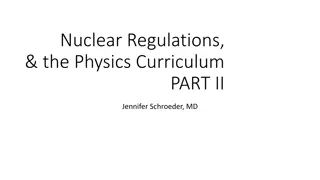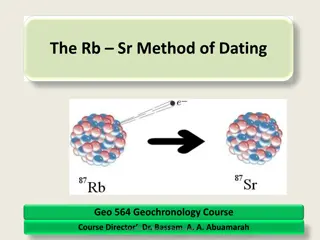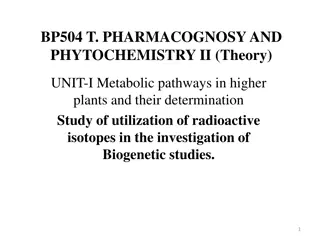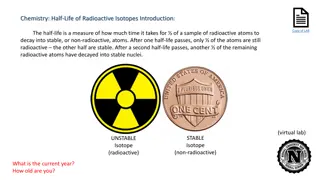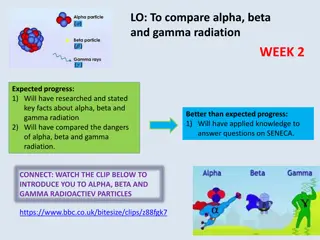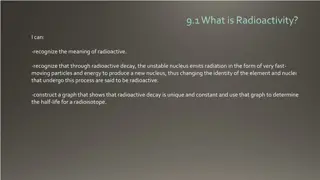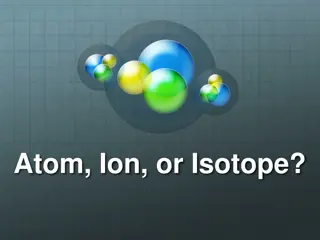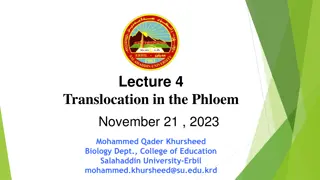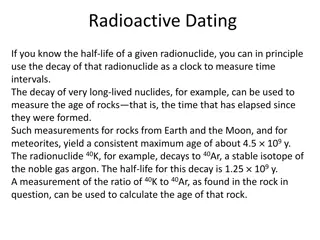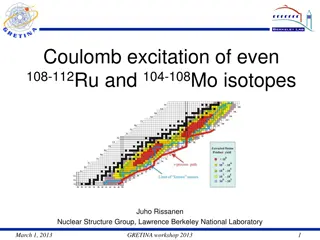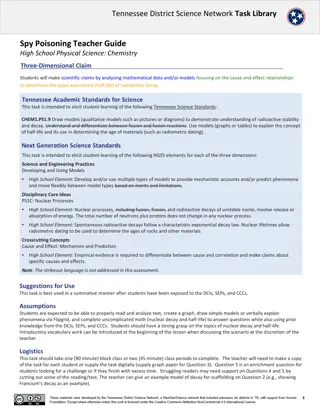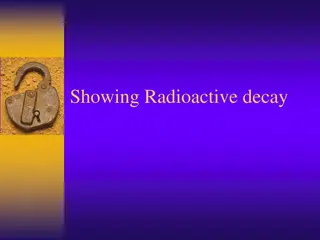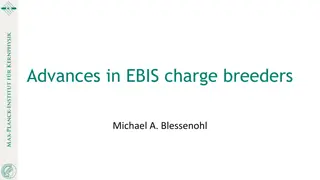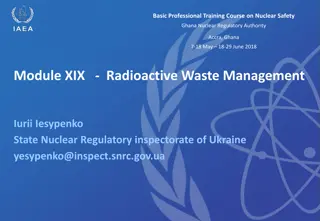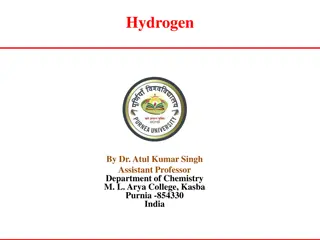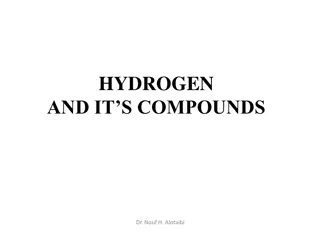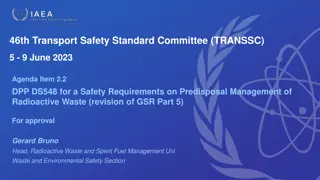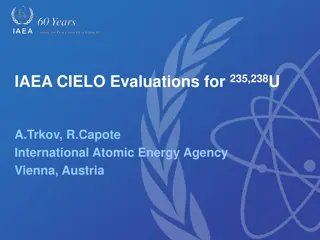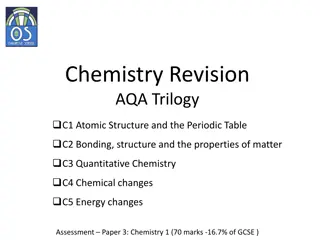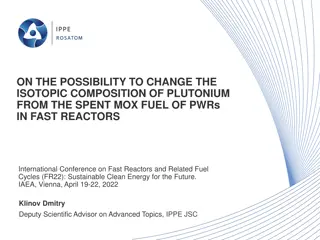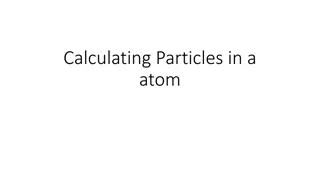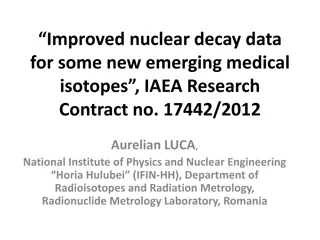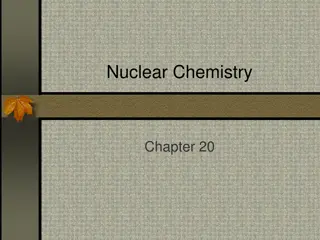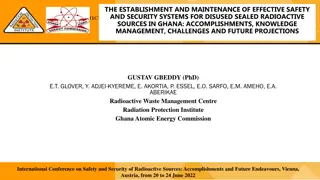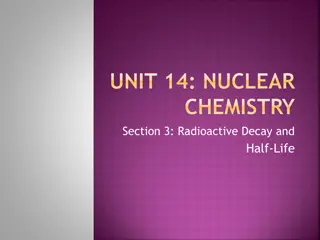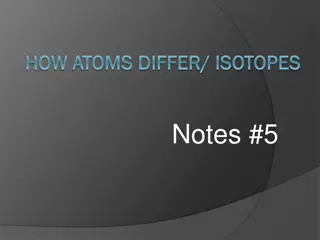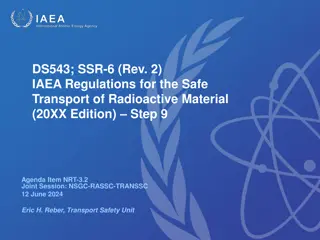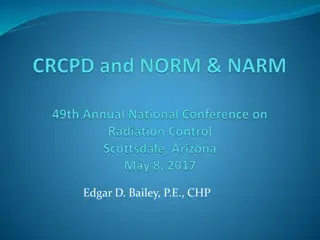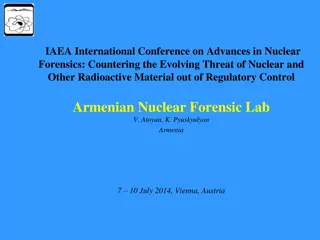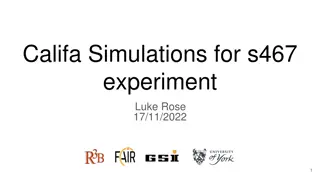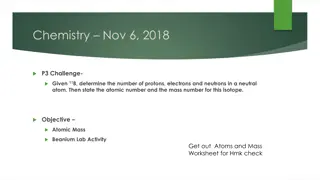Best Practices for Handling Radioactive Spills in Nuclear Medicine Facilities
Understanding the guidelines for dealing with radioactive spills is crucial in nuclear medicine. This comprehensive guide covers major and minor spill scenarios, steps to take in case of a spill, and special considerations for radioactive gas spills. Learn how to ensure safety, prevent contamination
1 views • 34 slides
Understanding the Rb-Sr Method of Dating in Geochemistry
Explore the principles of the Rb-Sr dating method in geochemistry, focusing on radioactive decay of Rubidium and Strontium isotopes in geological materials. Learn about isotope data presentation, application in dating geological processes, and the significance of Rb and Sr in the periodic table.
3 views • 62 slides
National Radioactive Waste Management Plan Overview
Briefing the Select Committee on Land Reform, Environment, Mineral Resources, and Energy about the South African Radioactive Waste Management Programme and the legislative background governing radioactive waste management. The presentation outlines the framework, guiding elements, waste management p
4 views • 19 slides
Evolution of Radiopharmacy: A Specialized Field in Pharmacy
The evolution of radiopharmacy as a specialty has progressed rapidly since the 1950s, involving the preparation, dispensing, and clinical investigation of radioactive materials as drugs. Radiopharmacy plays a crucial role in the development and use of radiopharmaceuticals for diagnostic, therapeutic
3 views • 53 slides
Production of Radiopharmaceuticals
Radiopharmaceuticals play a crucial role in medical imaging, with a significant portion containing Tc-99m that requires chemical modification. Various Tc-labeled radiopharmaceuticals like DTPA, HIDA, MIBI, and others are used for imaging. Desirable properties of radionuclides include half-life suita
9 views • 32 slides
Techniques for Investigating Plant Metabolic Pathways and Biogenetic Studies
This content explores various techniques used in pharmacognosy and phytochemistry to investigate the metabolic pathways in plants and study the formation of primary and secondary metabolites. Methods such as utilizing radioactive isotopes, tracer techniques, isolated organs/tissues, grafting, and mu
4 views • 12 slides
Exploring Radioactive Decay: A Half-Life Lab Simulation
Explore the concept of radioactive decay through a virtual lab simulation involving strontium-90 (Sr-90) and yttrium-90 (Y-90) isotopes. Witness the decay process over multiple half-lives as unstable atoms transform into stable nuclei. Dive into the intricacies of half-life measurements and the vast
0 views • 10 slides
Understanding Alpha, Beta, and Gamma Radiation: a Comparative Analysis
Explore the key differences between alpha, beta, and gamma radiation, their structures, penetration powers, absorption materials, ionizing abilities, and dangers. Learn about isotopes, radioactive decay, and the unique characteristics of each type of radiation. Dive into creating fact sheets and und
2 views • 7 slides
Understanding Radioactivity and Nuclear Radiation
Radioactivity is the process in which unstable nuclei emit radiation, such as alpha, beta, or gamma particles, to become stable. This emission can change the element's identity and is crucial in fields like nuclear power and understanding Earth's core heat source. Different radioactive isotopes like
0 views • 12 slides
Understanding Atoms, Ions, and Isotopes in Chemistry
Atoms are neutral with equal protons and electrons. Ions are charged atoms resulting from gaining or losing electrons, while isotopes are atoms with varying numbers of neutrons. The atomic number always signifies the number of protons in an atom, unaffected by electron or neutron changes. Explore th
2 views • 5 slides
Understanding Translocation in the Phloem
This lecture explores the process of translocation in the phloem, supported by evidence from studies such as aphid experiments, ringing experiments, and the use of radioactive isotopes. It delves into the materials translocated in phloem sap, including water, sucrose, non-reducing sugars, nitrogen c
5 views • 18 slides
Introduction to Atomic Masses and Mass Spectrometry
Understanding atomic masses, isotopes, and mass spectrometry in the context of chemistry, particularly the concept of standard atomic mass unit (amu) and its application in measuring the masses of atoms. The content delves into the composition of atoms, isotopes, and how to determine the mass of an
1 views • 20 slides
Understanding Radioactive Dating Methods
The process of radioactive dating involves utilizing the decay of radionuclides to measure time intervals, with applications in determining the age of rocks and artifacts. Techniques such as radiocarbon dating, based on isotopes like 14C, enable scientists to determine the age of organic materials b
0 views • 4 slides
Coulomb Excitation Studies of Neutron-Rich Ru and Mo Isotopes
Workshop presentation on using GRETINA, CHICO, and CARIBU for Coulomb excitation studies of even Ru and Mo isotopes, exploring shape evolution through systematic studies and experimental limitations like beam intensity and purity. Analysis includes gamma intensities, level schemes, and nuclear reori
1 views • 11 slides
Investigating Agent Z's Poisoning: A Case of Radioactive Decay
Agent Z, a double spy, was poisoned with Polonium-210, a heavy, radioactive element. This task challenges students to analyze the cause of his death using concepts of nuclear decay and half-life modeling based on provided data and models. The scenario involves understanding the effects of radioactiv
0 views • 14 slides
Understanding Radioactive Decay and Isotopes in Chemistry
Explore the fascinating world of radioactive decay, isotopes, and nuclear transformations in this educational resource. From reviewing atomic numbers to illustrating alpha and beta decay processes, discover the fundamental principles behind these phenomena with detailed explanations and visuals. Del
0 views • 17 slides
Understanding Atomic Mass and Isotopes in Atoms
Explore the concept of atomic mass in atoms, learn to compute atomic mass and mass number, identify isotopes, and calculate the number of neutrons in an atom. Understand the significance of the atomic number and mass number in determining the characteristics of elements.
0 views • 14 slides
Understanding Atomic Structure in Introductory Chemistry
Explore the basics of atomic structure in Introductory Chemistry, covering topics such as representing elements with atomic symbols, isotopes, and atomic bookkeeping. Learn through visual aids and examples to enhance your understanding of elements, isotopes, and atomic properties.
0 views • 21 slides
Advancements in Rare Isotope Research at EURISOL Town Meeting
Cutting-edge research and facility developments in the field of rare isotopes were showcased at the EURISOL Town Meeting in INFN - Pisa. Topics included advances in EBIS charge breeders, the ARIEL Extension facility, and the CANREB laboratory with Electron Beam Ion Source technology. Various aspects
0 views • 39 slides
Comprehensive Module on Radioactive Waste Management in Nuclear Safety Training
This module XIX on Radioactive Waste Management explores the generation, classification, treatment, storage, and disposal processes of radioactive waste. It covers the nature and sources of radioactive waste in medical, industrial, and research settings. The module also delves into the regulatory co
0 views • 106 slides
Overview of Hydrogen: Properties, Isotopes, and Characteristics
Hydrogen, a colorless gas with atomic number 1 and mass 1.008 amu, exhibits electropositive and electronegative characteristics due to its electron configuration. It has three isotopes - protium, deuterium, and tritium - with varying reaction rates. Protium is the most abundant isotope. This element
0 views • 8 slides
Exploring Hydrogen and Its Compounds: Properties and Isotopes
Hydrogen, the most abundant element in the universe, has unique properties that make it resemble both alkali metals and halogens. It exists mainly in combined states, except in volcanic gases, and its isotopes exhibit distinct chemical and physical characteristics. The ionization energy of the H-H b
0 views • 37 slides
Revision of Safety Requirements for Predisposal Management of Radioactive Waste at 46th TRANSSC
The 46th Transport Safety Standard Committee addresses the revision of GSR Part 5 concerning the predisposal management of radioactive waste. This update aims to harmonize safety requirements with current standards and establish protocols for the safe handling of all types of radioactive waste. The
0 views • 17 slides
Understanding Isotopes in Biogeochemistry
Isotopes are atoms with the same number of protons but different numbers of neutrons. This presentation explores the significance of stable isotopes, types of isotopes, expressing isotopic abundances, isotope effects, and applications to geochemical studies. Learn about common light element stable i
0 views • 14 slides
IAEA CIELO Evaluations for Uranium Isotopes & Criticality Benchmarks Report
This report discusses the IAEA CIELO evaluations for uranium isotopes, focusing on the impact of Standards_2016 on criticality predictions, adjustments in nuclear model calculations using the Empire code, and incorporation of experimental data to enhance performance in integral benchmarks.
0 views • 7 slides
Chemistry Revision: Atomic Structure and the Periodic Table - AQA Trilogy
Explore key concepts in Chemistry Revision for AQA Trilogy including atomic structure, periodic table organization, separation techniques, symbol equations, electron structures, isotopes, and more. Learn about burning magnesium, crystallization, chromatography, fractional distillation, and propertie
0 views • 10 slides
Innovations in Reprocessing Spent MOX Fuel for Sustainable Nuclear Energy
Discussion at the FR22 Conference focuses on the potential for fast reactors to modify the isotopic composition of plutonium from spent MOX fuel of PWRs. By utilizing fast reactors like BN-800, countries can alter the fissile isotopes in plutonium, enabling its reuse in thermal reactors and effectiv
0 views • 8 slides
Understanding Copper Atoms: Protons, Electrons, Neutrons, Isotopes
Explore the intricacies of copper atoms, including calculations for protons, electrons, neutrons, mass number, and isotopes. Learn about the importance of oxidation states and electron configurations from the periodic table. Discover the isotope notation and final details for the element copper.
0 views • 8 slides
Enhanced Nuclear Decay Data for Medical Isotopes Research
Improved nuclear decay data for emerging medical isotopes was evaluated as part of an IAEA research contract. The process involved reviewing previous evaluations, gathering experimental data, compiling decay data sets, and disseminating results. Challenges at IFIN-HH/LMR included limited funding and
0 views • 32 slides
Understanding Nuclear Chemistry: A Comprehensive Overview
Explore the world of nuclear chemistry in Chapter 20, covering stable and unstable isotopes, radioactivity, radiation exposure, radioactive particles, types of radiation (alpha, beta, gamma), and how to stop radiation. Learn about isotopes, decay processes, and the impact of radiation on our daily l
0 views • 18 slides
Effective Safety and Security Systems for Disused Sealed Radioactive Sources in Ghana
Ghana has benefited from the peaceful use of sealed radioactive sources in various sectors. The establishment of safety measures, security systems, and knowledge management for disused sealed radioactive sources (DSRS) is crucial. Challenges and future projections in this area are discussed, emphasi
0 views • 15 slides
Understanding Radioactive Decay and Half-Life in Nuclear Chemistry
Exploring the concept of radioactive decay and half-life in nuclear chemistry, this content covers the types of nuclear radiation, alpha decay of Uranium, and the significance of half-life in determining the decay of radioactive substances such as Carbon-14. An example with Fluorine-18 illustrates t
0 views • 9 slides
Understanding Average Atomic Mass Calculation
Dive into the concept of calculating average atomic mass through fractional and percentage abundances of isotopes. Practice examples with carbon and mercury isotopes to grasp the methodology effectively.
0 views • 20 slides
Understanding Atoms and Isotopes in Chemistry
Understanding atoms and isotopes is essential in chemistry. Atoms consist of protons, neutrons, and electrons that determine their properties. Isotopes are atoms of the same element with different atomic masses due to varying numbers of neutrons. Learning how to determine subatomic particles and ato
0 views • 17 slides
Understanding Atomic Structure and Radioactivity
Explore the composition of atoms with protons, neutrons, and electrons, and learn about isotopes, nuclear notation, and the properties of subatomic particles. Understand radioactivity, including alpha, beta, and gamma radiation, and their impact on atomic and mass numbers. Discover the significance
0 views • 30 slides
International Regulatory Framework for Radioactive Material Transport Safety
SSR-6 (Rev.1) establishes safety requirements for transporting radioactive material to protect people and the environment from ionizing radiation. The framework applies globally across land, water, and air transport modes, involving operations and conditions related to radioactive material movement.
0 views • 24 slides
Regulatory Evolution of Radioactive Materials Licensing
The regulatory landscape surrounding Naturally Occurring and Accelerator-Produced Radioactive Materials (NARM) underwent significant changes in the 20th century. Various entities, including AEC/NRC and states, grappled with the regulation of NARM, leading to a lack of consistency. Initiatives such a
0 views • 17 slides
Challenges and Solutions in Protecting Radioactive Sources in Post-USSR Armenia
The collapse of the USSR presented Armenia with challenges in managing radioactive materials due to limited resources and unclear responsibilities. Incidents of illicit trafficking of radioactive sources have been reported, highlighting the need for robust regulatory controls and forensic capabiliti
0 views • 20 slides
Califa Simulations and Experimental Observations in Nuclear Physics Research
Exploring nuclear physics research through Califa simulations and experimental observations with a focus on PID gating, clustering algorithms, beam settings, and Ca isotopes chain gating. The study involves simulating events on CH2 targets, analyzing clustering effects, and observing opening angles
0 views • 10 slides
Beanium Lab Activity: Calculating Average Atomic Mass of Beanium Isotopes
Explore the Beanium Lab Activity where you analyze the percent abundance and average mass of White, Milk, and Dark chocolate bean isotopes to calculate the average atomic mass of Beanium. Understand the weighted average concept and how it relates to atomic mass calculations in chemistry.
0 views • 7 slides
